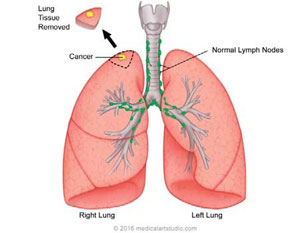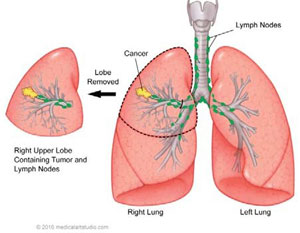Lung Resection
Lung resection is a surgical procedure performed to remove all or part of the lung. A lung resection is typically performed to treat an infection or disease of the lungs such as cancer, emphysema, or bronchiectasis. Lung resection can be performed via the following methods: Minimally-Invasive (small incisions of 2–3 inches long / general anesthesia) or open-surgery (large incisions of 8-10 inches long / general anesthesia). Based on your specific medical condition, your doctor will choose the most appropriate method.
Types of Lung Resection
There are three types of lung resection:
- Wedge Resection: A wedge resection involves the removal of lung cancer along with a wedge-shaped section of tissue surrounding the tumor. This procedure removes less lung tissue than a lobectomy.
- Lobectomy: The most common type of lung resection. In this procedure, one or multiple lobes are removed from your lungs. A lobectomy removes one of these lobes that may be damaged from disease or an infection. Lobectomy is usually the main treatment for people with: Early stages of lung cancer, tuberculosis, emphysema, bronchiectasis, non-cancerous (benign) tumors, and fungal infections.
- Pneumonectomy: In this procedure, the entire lung is removed because of cancer, trauma, or some other condition.
"Wedge" Resection

Lobectomy

Pneumonectomy

How to Prepare for Lung Resection Procedure
Prior to the procedure, your doctor and treatment team will explain to you what to expect before, during and after the procedure and potential risks of the procedure. Talk to your doctor about:
- All medications, herbal products and dietary supplements you are currently taking and ask for their recommendations about each.
- Radiation exposure, especially for those that are pregnant.
- Any allergies to medicines, latex, tape, iodine, and anesthetic agents.
- Any history of bleeding disorders.
- Any body piercings on your chest or abdomen.
Other recommendations include:
- Eat a normal meal the evening before the procedure. However, do not eat, drink or chew anything after midnight before your procedure. If you must take medications, only take them with sips of water.
- Leave all jewelry at home.
- Remove all makeup and nail polish.
- Wear comfortable clothing when you come to the hospital.
- If you normally wear dentures, glasses, or hearing devices at home, plan to wear them during the procedure.
What to Expect Before Lung Resection Procedure
To determine whether you need a lung resection, your doctor might perform a variety of diagnostic tests, including:
- Chest X-Rays
- Computed tomography (CT scan)
- Magnetic resonance imaging (MRI)
- Tissue biopsy
- Bronchoscopy
- Positon-Emission tomography (PET)
What to Expect During Lung Resection Procedure
A lung resection will typically take anywhere from 2 to 3 hours to complete. This procedure is typically performed in the cardiothoracic operating room (OR). Check with your doctor about the details of your procedure. In general, during a minimally-invasive lobectomy:
- You will change into a hospital gown.
- A nurse will start the intravenous (IV) line in your arm which will administer medications and fluids during the procedure.
- Usually, your doctor will administer general anesthesia (make you feel sleepy).
- Once you are sedated, your doctor may insert a breathing tube through your throat into your lungs and connect you to a ventilator. This will breathe for you during surgery.
- Your doctor will make several small incisions on the side between your ribs to reach the lungs and insert a camera for guidance.
- Your doctor will then proceed to remove one or multiple lobes from your lungs.
- The doctor will place tubes into your chest to drain fluids and air as you recover.
- Once the overall procedure is complete, your doctor will close up the incision with stitches or staples, and you will be moved to the recovery area.
What to Expect After Lung Resection Procedure
After the surgery, you will be taken to the stepdown unit. Patients having lung resection typically stay in the hospital 2-5 days. Other recommendations include:
General Guidelines
- Your recovery process will vary depending on the type of procedure done. The incision sites will be checked often.
- The breathing tube is removed when you wake up from anesthesia.
- Diet is started the day after surgery with liquids, and quickly advanced to solids as tolerated.
- Ambulation is started on the first or second day of surgery.
- Urine catheters and drainage tubes (chest tubes) are removed after 24 to 72 hours.
- You can probably do your normal activities after the surgery. But, you may need to take it easy at first. No heavy lifting or vigorous exercises until your body has healed.
- Your doctor will give you instructions to follow during your recovery.
